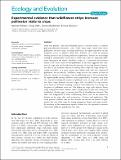Files in this item
Experimental evidence that wildflower strips increase pollinator visits to crops
Item metadata
| dc.contributor.author | Feltham, H. | |
| dc.contributor.author | Park, K. | |
| dc.contributor.author | Minderman, J. | |
| dc.contributor.author | Goulson, D. | |
| dc.date.accessioned | 2015-08-11T12:10:07Z | |
| dc.date.available | 2015-08-11T12:10:07Z | |
| dc.date.issued | 2015-08-19 | |
| dc.identifier | 208927317 | |
| dc.identifier | e8d8cee4-27a2-43aa-a068-fc7b9b7b5752 | |
| dc.identifier | 84939473875 | |
| dc.identifier.citation | Feltham , H , Park , K , Minderman , J & Goulson , D 2015 , ' Experimental evidence that wildflower strips increase pollinator visits to crops ' , Ecology and Evolution , vol. 5 , no. 16 , pp. 3523–3530 . https://doi.org/10.1002/ece3.1444 | en |
| dc.identifier.issn | 2045-7758 | |
| dc.identifier.uri | https://hdl.handle.net/10023/7183 | |
| dc.description | This study was financially supported by the Natural Environment Research Council and the Economic and Social Research Council. Date of Acceptance: 06/01/2015 | en |
| dc.description.abstract | Wild bees provide a free and potentially diverse ecosystem service to farmers growing pollination-dependent crops. While many crops benefit from insect pollination, soft fruit crops, including strawberries are highly dependent on this ecosystem service to produce viable fruit. However, as a result of intensive farming practices and declining pollinator populations, farmers are increasingly turning to commercially reared bees to ensure that crops are adequately pollinated throughout the season. Wildflower strips are a commonly used measure aimed at the conservation of wild pollinators. It has been suggested that commercial crops may also benefit from the presence of noncrop flowers; however, the efficacy and economic benefits of sowing flower strips for crops remain relatively unstudied. In a study system that utilizes both wild and commercial pollinators, we test whether wildflower strips increase the number of visits to adjacent commercial strawberry crops by pollinating insects. We quantified this by experimentally sowing wildflower strips approximately 20 meters away from the crop and recording the number of pollinator visits to crops with, and without, flower strips. Between June and August 2013, we walked 292 crop transects at six farms in Scotland, recording a total of 2826 pollinators. On average, the frequency of pollinator visits was 25% higher for crops with adjacent flower strips compared to those without, with a combination of wild and commercial bumblebees (Bombus spp.) accounting for 67% of all pollinators observed. This effect was independent of other confounding effects, such as the number of flowers on the crop, date, and temperature. Synthesis and applications. This study provides evidence that soft fruit farmers can increase the number of pollinators that visit their crops by sowing inexpensive flower seed mixes nearby. By investing in this management option, farmers have the potential to increase and sustain pollinator populations over time. | |
| dc.format.extent | 8 | |
| dc.format.extent | 132697 | |
| dc.language.iso | eng | |
| dc.relation.ispartof | Ecology and Evolution | en |
| dc.subject | Agriculture | en |
| dc.subject | Bombus | en |
| dc.subject | Commercial pollinators | en |
| dc.subject | Ecosystem service | en |
| dc.subject | Management | en |
| dc.subject | Sustainability | en |
| dc.subject | Wild bees | en |
| dc.subject | QH301 Biology | en |
| dc.subject | NDAS | en |
| dc.subject.lcc | QH301 | en |
| dc.title | Experimental evidence that wildflower strips increase pollinator visits to crops | en |
| dc.type | Journal article | en |
| dc.contributor.institution | University of St Andrews. School of Biology | en |
| dc.identifier.doi | https://doi.org/10.1002/ece3.1444 | |
| dc.description.status | Peer reviewed | en |
This item appears in the following Collection(s)
Items in the St Andrews Research Repository are protected by copyright, with all rights reserved, unless otherwise indicated.

